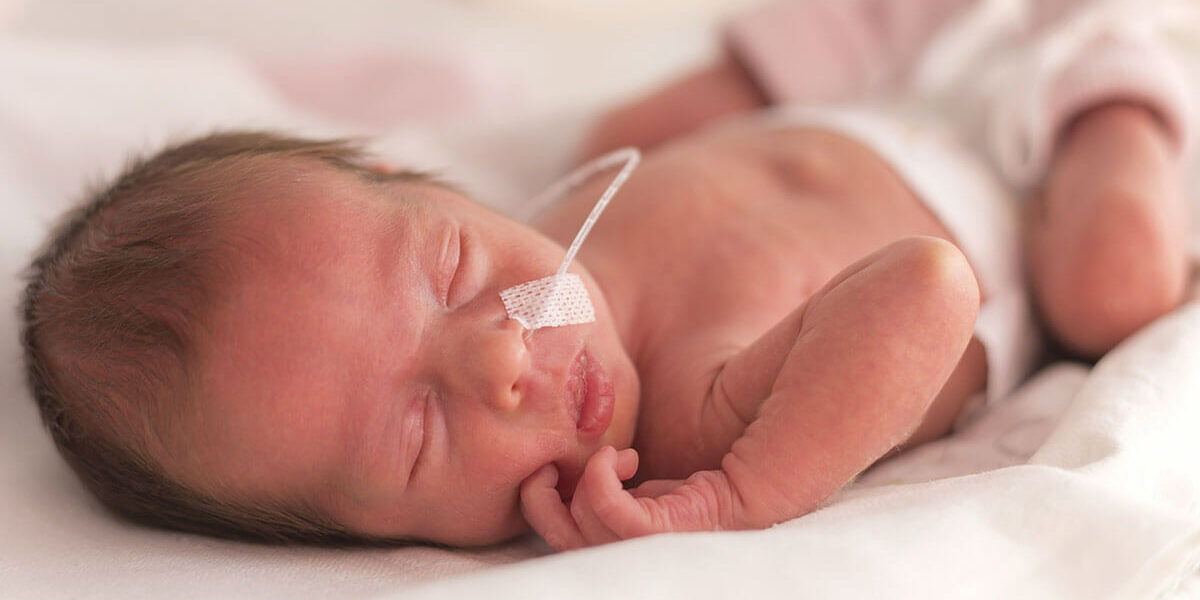For most mothers pregnancy is a safe and straightforward process but for 1 in 5 unexpected complications can occur and are a major cause of childhood disability. The research we fund at the University of Leeds aims to improve the prediction of mums at risk of early delivery and to prevent it from happening so that fewer babies need neonatal intensive care and do not suffer the complications of being born too early.
In this article Georgia Mappa, Lead Research Officer at Leeds, explains what prematurity is, what causes it and what the complications may be as well as how prematurity is treated and ways to help prevent a preterm birth.
Key facts
- Premature birth is birth that happens before 37 weeks of pregnancy.
- Preterm birth complications are the leading cause of death among children under 5 years of age.
- Babies born prematurely may have serious health problems at birth and later in life. In general, the more premature the baby, the more serious and long-lasting the health problems may be.
What is prematurity?
Prematurity, also known as preterm birth, is the birth of a baby before 37 weeks of pregnancy. A normal pregnancy lasts between 37 and 41 completed weeks, with a full-term delivery usually around 40 weeks.
Globally, prematurity is the leading cause of death in children under the age of 5 years (1). In the UK, about 8 babies out of every 100 are born too soon (2). There are risks to the baby from being born early, and the earlier a baby is born, the higher their chances of health problems at birth and later in life.
What causes prematurity?
Preterm birth occurs for a variety of reasons. Most preterm births happen spontaneously, but some are due to early induction of labour or caesarean birth, for medical reasons.
Common causes of preterm birth include multiple pregnancies (carrying more than one baby), infections and chronic conditions such as diabetes and high blood pressure, stress and problems with the uterus. Often, the exact cause of prematurity is not clear. However, there are known risk factors of premature delivery, including:
- Having a previous premature birth
- Pregnancy with twins, triplets or other multiples
- Getting pregnant within a short time (less than a year) after having had a baby
- Problems with the uterus, cervix or placenta
- Smoking cigarettes, or using illicit drugs
- Infection, particularly of the amniotic fluid and lower genital tract
- Some chronic conditions, such as high blood pressure and diabetes
- Stress
- Multiple miscarriages or abortions
- Physical injury or trauma
Nevertheless, premature birth can happen to anyone, with many pregnant women having no known risk factors.
What are the complications of prematurity?
While not all premature babies experience complications, being born too early can cause short-term and long-term health problems. Generally, the earlier in the pregnancy a baby is born, the more vulnerable they are.
Some problems may be apparent at birth, while others may not develop until later. The most common symptoms of a premature baby are:
- Small size (less than 5 pounds, 8 ounces)
- Fine hair (lanugo) covering much of the body
- Thin, shiny, pink, or red skin
- Little body fat
- Weak cry
- Low muscle tone
Short-term complications and special care
Babies born early will likely need care in hospital with specialist facilities for premature babies (the neonatal unit). Because premature babies are born before their bodies and organ systems have completely matured they may not be able to function well.
Some of the problems premature babies may have include:
- Keeping their body temperature steady, or staying warm.
- Breathing problems.
- Blood problems, which include low red blood cell counts (anaemia), yellow-colour to the skin from breaking down old red blood cells (jaundice), or low blood sugar levels (hypoglycaemia).
- Digestive problems, including trouble feeding and poor digestion. In some cases there may be severe inflammation of parts of the intestine (necrotizing enterocolititis).
- Nervous system problems, including bleeding in the brain, or seizures.
- Infections, including sepsis, an infection that spreads to the bloodstream.
- Heart problems, including patent ductus arteriosus (PDA) and low blood pressure (hypotension). PDA is a persistent opening between the aorta and pulmonary artery. While this heart defect often closes on its own, left untreated it can lead to a heart murmur, heart failure as well as other complications.
Long-term complications
Premature babies can have long-term health problems as well. Generally, the more premature the baby, the more serious and long-lasting the health problems may be:
- Cerebral palsy. Cerebral palsy is a disorder of movement, muscle tone or posture that can be caused by infection, or injury to a newborn’s developing brain either early during pregnancy, or while the baby is still young and immature.
- Impaired learning. Premature babies are more likely to lag behind their full-term counterparts on various developmental milestones. Upon school age, a child who was born prematurely might be more likely to have learning disabilities.
- Behavioural problems and mental health conditions. Children who experienced premature birth may be more likely than full-term infants to have attention deficit hyperactivity disorder (ADHD), anxiety or depression later in life.
- Vision problems. Premature infants may develop retinopathy of prematurity (ROP). This is an eye disease that occurs when blood vessels swell and overgrow in the light-sensitive layer of nerves at the back of the eye (retina). It usually affects both eyes and can impair vision.
- Hearing problems. Premature babies are at increased risk of some degree of hearing loss.
- Dental problems. Premature babies may have delayed tooth growth, changes in tooth colour or teeth that grow crooked or out of place as they get older.
- Chronic health issues. Premature babies are more likely to have chronic health issues, some of which may require hospital care, than are full-term infants. Infections, asthma and feeding problems are more likely to develop or persist. Premature infants are also at increased risk of sudden infant death syndrome (SIDS).
How is prematurity treated?
Although the exact cause of preterm birth is often unknown, there are treatments that may help reduce the risk of preterm birth and its associated complications for the baby which include:
- Progesterone supplements. Women who have a history of preterm birth may be able to reduce the risk of preterm birth with progesterone supplementation.
- Cervical cerclage. This is a surgical procedure performed during pregnancy in women with a short cervix, or a history of cervical shortening that resulted in a preterm birth. During this procedure, the cervix is stitched closed with strong sutures that may provide extra support to the uterus, which are removed before delivery.
- Antibiotics. To reduce the risk of an infection getting into the womb, affecting both mother and baby, and delay labour.
- Steroid injections (corticosteroids) to help with the baby’s development (especially the lungs) and to reduce the chance of problems caused by being born prematurely.
- Magnesium sulphate. A medication offered to women at high risk of preterm birth, which can reduce the risk of the baby developing cerebral palsy.
Preventing prematurity
Preventing neonatal deaths and complications from preterm birth starts with a healthy pregnancy. WHO’s antenatal care guidelines recommend key interventions to help prevent preterm birth, such as counselling on healthy diet and optimal nutrition, and tobacco and substance use; foetal measurements including use of ultrasound to help determine gestational age and detect multiple pregnancies; and a minimum of eight contacts with health professionals throughout pregnancy to identify and manage other risk factors, such as infections.
Although more babies are surviving, even though they are born early and are very small, preterm birth remains a crucial issue in child mortality and reflects the great need for more extensive studies that will allow researchers and clinicians to better understand the complex and often unknown causes of prematurity. Such understanding will facilitate the implementation of preventive innervations, improve quality of maternal and new-born care and help reduce the incidence and burden of long-term disabilities associated with prematurity, particularly those related to brain injury.
Sources
WHO. Preterm birth. [Online]. 2018. [Accessed 2021].
NHS. Premature labour and birth. [Online]. 2020. [Accessed 2021].
Mayo. Premature birth. [Online]. 2021. [Accessed 2021].
Tommy’s. Waters breaking early (PPROM). [Online]. 2020. [Accessed 2021].
RCOG. When your waters break prematurely. [Online]. 2019. [Accessed 2021].
NICE. Preterm labour and birth. [Online]. 2019. [Accessed 2021].









